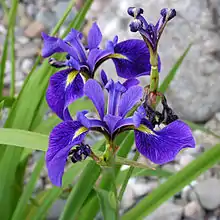Iris versicolor
Iris versicolor is also commonly known as the blue flag, harlequin blueflag, larger blue flag, northern blue flag,[1] and poison flag, plus other variations of these names,[2][3] and in Britain and Ireland as purple iris.[4]
| Iris versicolor | |
|---|---|
 | |
| Scientific classification | |
| Kingdom: | Plantae |
| Clade: | Tracheophytes |
| Clade: | Angiosperms |
| Clade: | Monocots |
| Order: | Asparagales |
| Family: | Iridaceae |
| Genus: | Iris |
| Subgenus: | Iris subg. Limniris |
| Section: | Iris sect. Limniris |
| Series: | Iris ser. Laevigatae |
| Species: | I. versicolor |
| Binomial name | |
| Iris versicolor | |
It is a species of Iris native to North America, in the Eastern United States and Eastern Canada. It is common in sedge meadows, marshes, and along streambanks and shores. The specific epithet versicolor means "variously coloured".[5]
It is one of the three Iris species in the Iris flower data set outlined by Ronald Fisher in his 1936 paper "The use of multiple measurements in taxonomic problems" as an example of linear discriminant analysis.[6]
Description
Iris versicolor is a flowering herbaceous perennial plant, growing 10–80 cm (4–31 in) high. It tends to form large clumps from thick, creeping rhizomes. The unwinged, erect stems generally have basal leaves that are more than 1 cm (1⁄2 in) wide. Leaves are folded on the midribs so that they form an overlapping flat fan. The well developed blue flower has 6 petals and sepals spread out nearly flat and have two forms. The longer sepals are hairless and have a greenish-yellow blotch at their base. The inferior ovary is bluntly angled. Flowers are usually light to deep blue (purple and violet are not uncommon) and bloom during May to July. Fruit is a 3-celled, bluntly angled capsule. The large seeds can be observed floating in fall.
Chemical constituents
The species has been implicated in several poisoning cases of humans and animals who consumed the rhizomes, which have been found to contain a glycoside, iridin. The sap can cause dermatitis in susceptible individuals.
Toxicity and uses
Both the leaves and roots are poisonous, and can cause stomach and intestinal inflammation. Consuming the plant can be fatal to calves.[7]
The iris has been used as magical plant, with people carrying the root (or rhizome) to get 'financial gain', or it was placed in cash registers to increase business.[8]
Symbolism
The iris is the official state flower of the U.S. state of Tennessee. This designation was made in 1933 by the state legislature. Although the law does not specifically define a type of iris, it is generally accepted that the purple iris is the state flower.[9]
The blue flag is the provincial flower of Quebec, having replaced the Madonna lily which is not native to the province.[10]
The Purple Iris is the official flower of Kappa Pi International Honorary Art Fraternity.[11]
Gallery
_-_United_States_National_Arboretum_-_(1).jpg.webp) Iris versicolor 'Blue Flag'
Iris versicolor 'Blue Flag' Iris versicolor
Iris versicolor Iris versicolor - botanical illustration in American Medicinal Plants, 1887
Iris versicolor - botanical illustration in American Medicinal Plants, 1887
References
- ROM Field Guide to Wildflowers of Ontario. Toronto:Royal Ontario Museum, 2004.
- Muma, Walter. "Blue Flag Iris". Ontario Wildflowers. ontariowildflowers.com. Retrieved 12 November 2014.
- Thomas Lathrop Stedman (editor) Stedman's Medical Dictionary for the Health Professions and Nursing , p. 406, at Google Books
- "BSBI List 2007". Botanical Society of Britain and Ireland. Archived from the original (xls) on 2014-10-23. Retrieved 2014-10-17.
- Stearn, W.T. (2004). Botanical Latin (4th (p/b) ed.). Portland, Oregon: Timber Press. p. 527. ISBN 978-0-7153-1643-6.
- R. A. Fisher (1936). "The use of multiple measurements in taxonomic problems" (PDF). Annals of Eugenics. 7 (2): 179–188. doi:10.1111/j.1469-1809.1936.tb02137.x. hdl:2440/15227.
- Elias, Thomas S.; Dykeman, Peter A. (2009) [1982]. Edible Wild Plants: A North American Field Guide to Over 200 Natural Foods. New York: Sterling. p. 261. ISBN 978-1-4027-6715-9. OCLC 244766414.
- Cunningham, Scott (1999). Cunningham's Encyclopedia of Magical Herbs. Llewellyn. p. 168. ISBN 0-87542-122-9.
- "State of Tennessee". state.tn.us.
- (in French) Gouvernement du Québec Emblèmes du Québec - Iris versicolor
- Article I, Section 2. "International Constitution of Kappa Pi" (PDF). Kappa Pi International Honorary Art Fraternity Inc.
External links
| Wikimedia Commons has media related to Iris versicolor. |